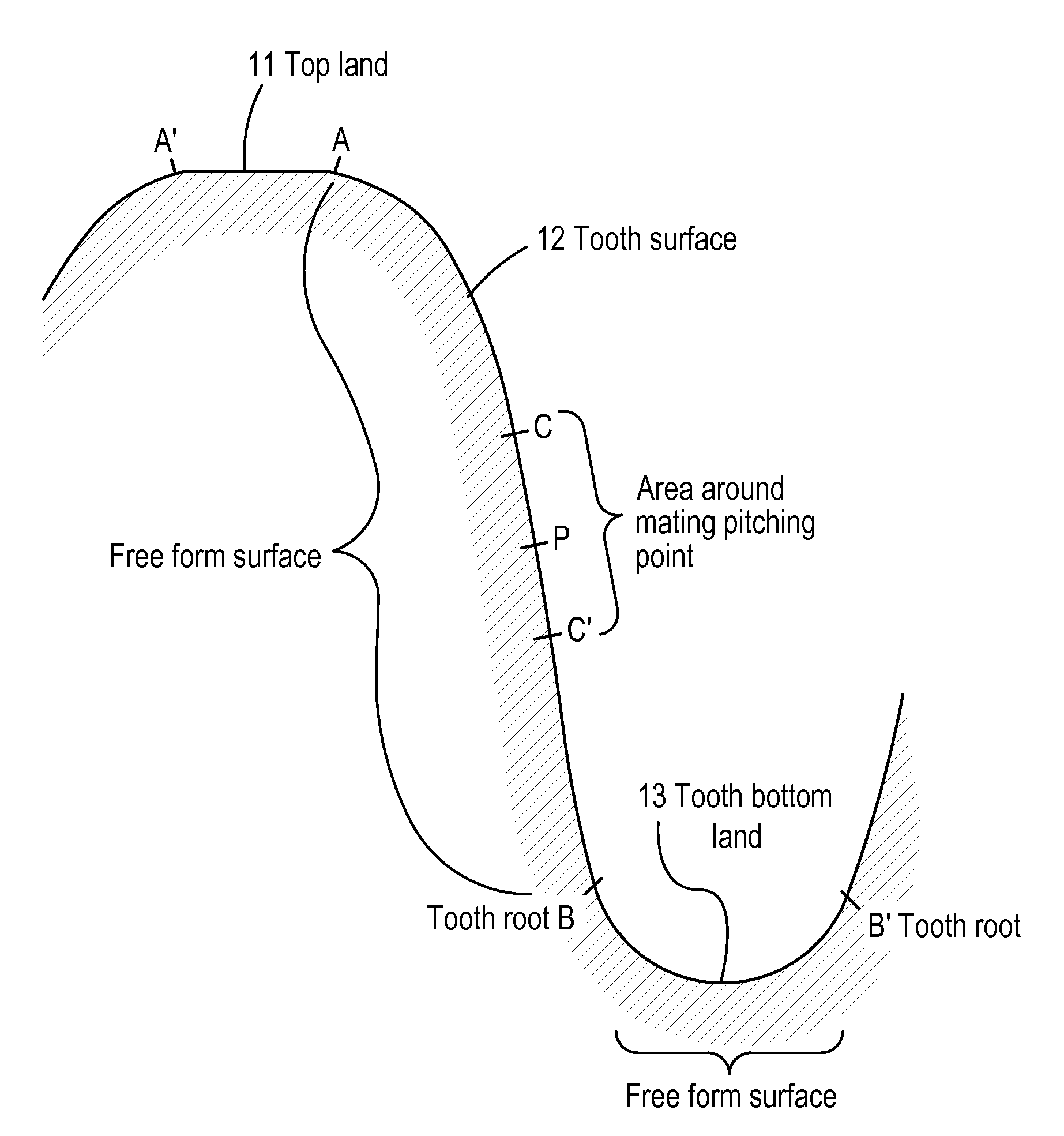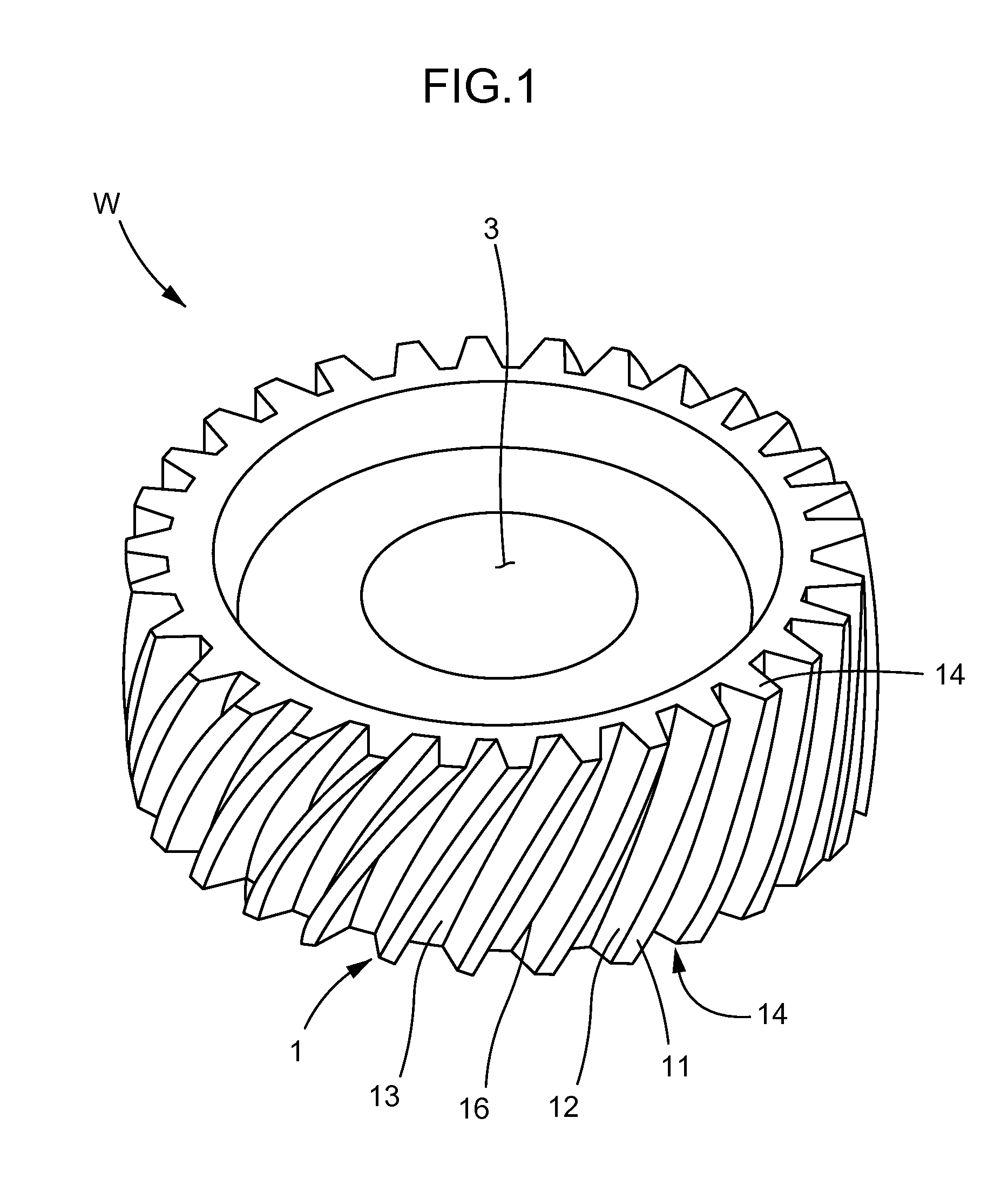Free-form surface gear
a surface gear and free-form technology, applied in the field of transmission gears, can solve the problems of reducing the life of the transmission gear, requiring a complex cutting tool, and a long time for cutting each tooth, so as to increase the fatigue strength and increase the fatigue strength
- Summary
- Abstract
- Description
- Claims
- Application Information
AI Technical Summary
Benefits of technology
Problems solved by technology
Method used
Image
Examples
first embodiment
[0033]The present embodiment is applied to a spur gear or a helical gear. The present embodiment will be described with reference to FIGS. 1 and 2. FIG. 1 is a perspective view of a transmission gear according to the present embodiment. FIG. 2 is a sectional view of a tooth profile formed of a single free-form surface.
[0034]The name of each part of the transmission gear according to the present embodiment illustrated in FIG. 1 will now be described. Each of helical teeth 1 at the outer periphery of the transmission gear W includes a top land 11 that extends in a tooth trace direction, tooth surfaces 12 at the left and right sides of the top land 11, bottom lands 13 on which the tooth surfaces 12 stand, tooth end faces 14 and 14 at the top and bottom ends in the tooth trace direction, and a tooth root 16. Here, the tooth profile of the helical teeth 1, whose tooth trace direction is helical with respect to a rotational axis direction of the gear, will be described.
[0035]FIG. 2 is a n...
second embodiment
[0037]The present embodiment is applied to a spur gear or a helical gear. Here, a spur gear will be described with reference to FIG. 3. The present embodiment differs from the first embodiment in that the tooth surface is formed of a compound free-form surface. The difference from the first embodiment will be mainly described below. A sectional view along a plane perpendicular to the axis that differs from FIG. 2 is shown in FIG. 3. The tooth surface is formed of a compound free-form surface, and the bottom land is formed of a single free-form surface. The overall tooth profile is formed of a compound free-form surface 3. In the free-form surface 3 of the tooth profile, the tooth surface is formed of a compound surface of three types of surfaces, which are an epitrochoid surface in the area between symbols A and C, a cycloid surface in the area between symbols C and C′, and a trochoid surface in the area between symbols C′ and B. The bottom land in the area between symbols B and B′ ...
third embodiment
[0041]The present embodiment is applied to a helical gear. The helical gear includes a helicoid surface having a helix angle obtained by subjecting a tooth surface to a bias modification. The present embodiment will be described with reference to FIGS. 4 and 5. The present embodiment differs from the first and second embodiments in that the tooth surface is subjected to the bias modification. FIG. 4 is a perspective view of a tooth profile having a free-form surface obtained by subjecting the tooth surface to a bias-in modification. FIG. 5 is a perspective view of a tooth profile having a free-form surface obtained by subjecting the tooth surfaces to a bias-out modification.
[0042]Before describing the tooth profile, gear terms will be explained. There are two types of methods, which are the bias-in modification and the bias-out modification, for twisting the tooth surface. In the bias-in modification, the tooth surface of the gear is twisted such that the tooth surface is lowered at...
PUM
| Property | Measurement | Unit |
|---|---|---|
| thickness | aaaaa | aaaaa |
| radius of curvatures | aaaaa | aaaaa |
| radius of curvature | aaaaa | aaaaa |
Abstract
Description
Claims
Application Information
 Login to View More
Login to View More - R&D
- Intellectual Property
- Life Sciences
- Materials
- Tech Scout
- Unparalleled Data Quality
- Higher Quality Content
- 60% Fewer Hallucinations
Browse by: Latest US Patents, China's latest patents, Technical Efficacy Thesaurus, Application Domain, Technology Topic, Popular Technical Reports.
© 2025 PatSnap. All rights reserved.Legal|Privacy policy|Modern Slavery Act Transparency Statement|Sitemap|About US| Contact US: help@patsnap.com



